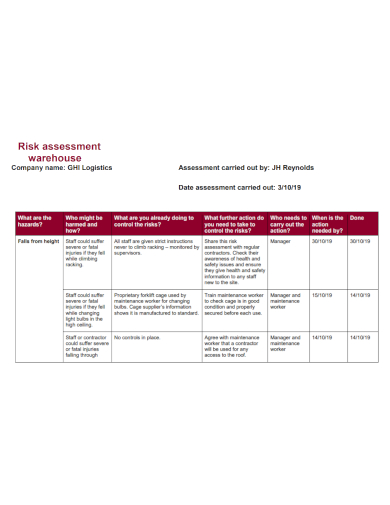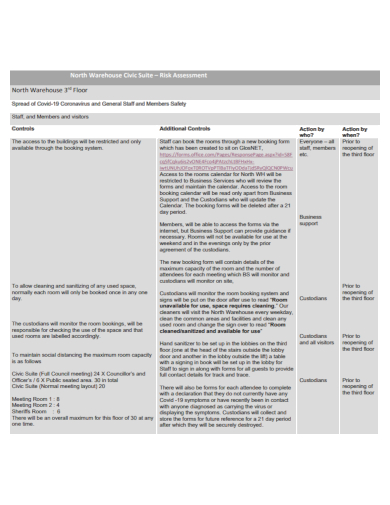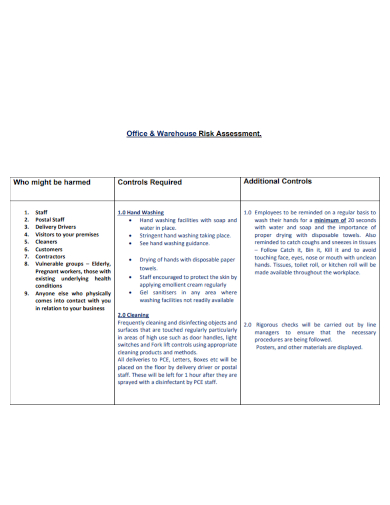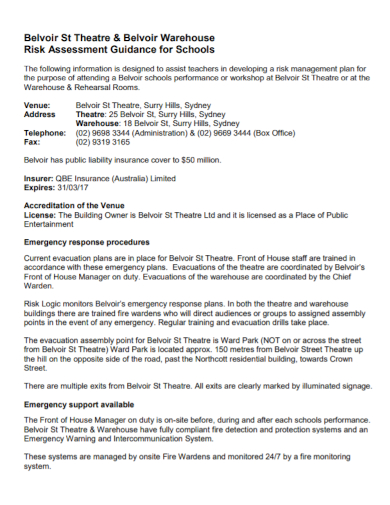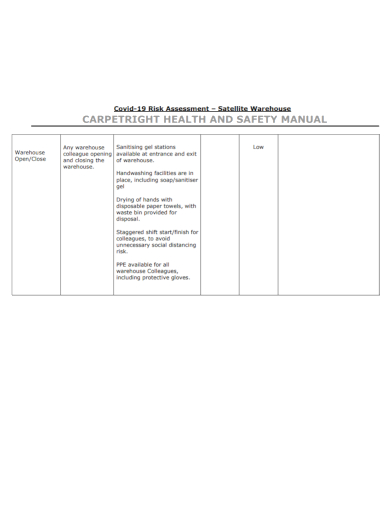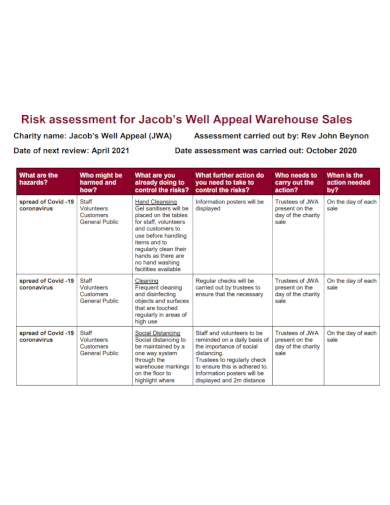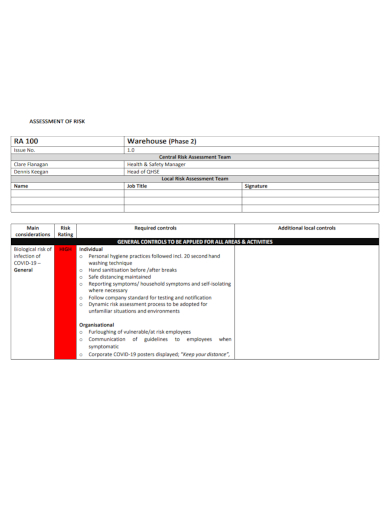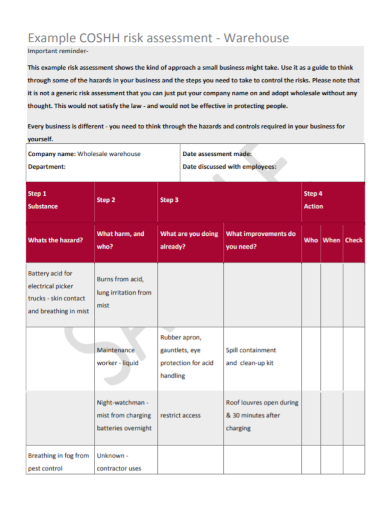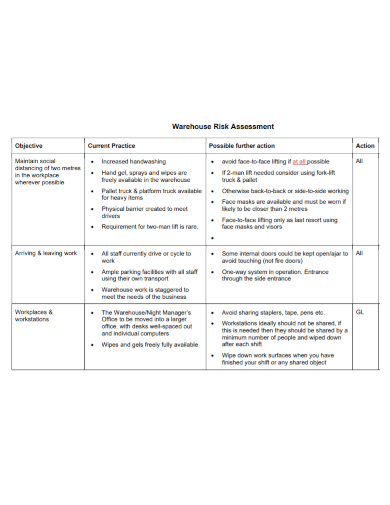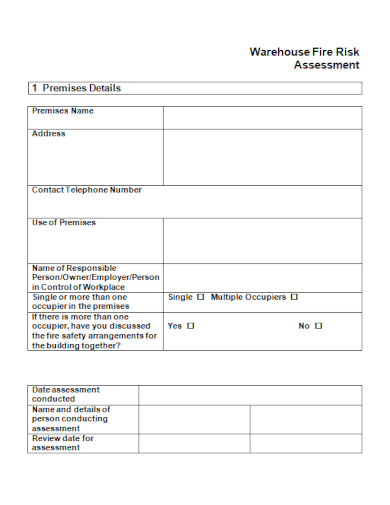Warehouses are huge enclosed areas where a huge number of stocks of different types of products are stored to keep from getting damaged by various factors. To ensure that warehouses are fully functional, the staff is usually designated to maintain the operations within the warehouse running smoothly all the time. With heavy and large machinery and objects being operated by the staff, there are more chances of safety risks that could happen and injure people or cause damages. However, these risks can be mitigated if the warehouse staff can assess the risks present in the warehouse and make a protocol to lessen the likelihood of these risks happening. Read the article to find out how to make a warehouse risk assessment.
10+ Warehouse Risk Assessment Samples
1. Company Warehouse Risk Assessment
2. Warehouse Environment Risk Assessment
3. Warehouse Suite Risk Assessment
4. Office Warehouse Covid Risk Assessment
5. School Warehouse Risk Assessment
6. Satellite Warehouse Risk Assessment
7. Warehouse Sales Risk Assessment
8. Warehouse Team Risk Assessment
9. Wholesale Warehouse Risk Assessment
10. Warehouse Action Risk Assessment
11. Warehouse Fire Risk Assessment
What is Risk Assessment?
Risk assessment refers to the process of evaluating risk to the safety of the workers. It refers to identifying workplace hazards and putting into place protective measures that would help control the risks of these hazards. Risk assessment helps you eliminate any hazards that can potentially damage the functioning of your warehouse and cause harm to the resources that carry out the operations.
How to Do a Warehouse Risk Assessment
1. Identify Hazards
Assess all the activities inside the warehouse to identify every potential hazard or accident that could occur and take note of it to help you decide what safety protocols you can add to your existing one.
2. Determine Who is at Risk
The next thing to do is to determine which workers are more likely at risk of any warehouse hazards. Determine ways on how they can be protected from these hazards. You can include this in your safety protocol.
3. Assess the Risks
Next is to evaluate the risks that come with your operations to the workers. Determine how likely these operations might cause potential harm to the workers. Review any past incidents of which accidents occurred and figure out if you should reduce the level of operational risks. To effectively evaluate the risks in the warehouse operations, categorize each in a level of a hazard: high, medium, or low.
4. Record Observations
After evaluating the risks, observe the warehouse operations in real-time. Then record these observations. Make sure your observations are detailed and thoroughly recorded. The information that was input in the observation will be useful for the next step.
5. Update Your Current Protocols and Review Its Effectiveness Regularly
From your risk evaluation and observation data, apply these to update your safety protocol. Implement the changes by training your staff with health and safety training and changing some processes within the warehouse operations to lessen the potential risks happening. Make sure to review your updated protocols at fixed intervals to ensure that agreed safe working practices continue to be applied and if there are any new machinery or new processes to work on.
Risks in Warehouse That Are Likely to Happen
- Physical Strain: Warehouse workers often handle heavy, bulky items and this can cause muscle strains. Workers must be trained on how to safely handle big and heavy items and lessen the likelihood of severe physical stress by using equipment to handle heavy items.
- Loading and Unloading: Loading and unloading items are one of the main activities in the warehouse. Risks when doing these can be falling objects or getting hit or pinned by equipment. Workers must be trained on how to properly handle equipment and the items they unload and load.
- Slips and Trips: Slipping and tripping are not uncommon mini accidents that could happen. Workers must be trained to wear proper footwear, proper lighting to be installed in the warehouse, and pathways should be free from obstruction.
- Working at Heights: Working at height is a great hazard that could lead to fatal injuries and damaged items. Safety harnesses and equipment must be used while working at high places.
- Fire Hazards: Fire can spread quickly inside a warehouse since these places have little ventilation and are stored with goods that are sometimes highly flammable. Damaged items, destruction of the warehouse, and injuries could be the result of the fire costing a lot of money to make up for the lost goods and insurance. Warehouses must have fire extinguishers, sprinklers, smoke detectors, and workers must be properly trained with the fire evacuation plan.
FAQs
What are the types of risk assessments?
The different types of risk assessments are qualitative risk assessment, quantitative risk assessment, generic risk assessments, site-specific risk assessments, and dynamic risk assessments.
What is the difference between risk analysis and risk assessment?
A risk assessment involves a process of assessing the risk management plan or protocol of an institution and risk analysis is part of the steps of risk assessment.
What are the different types of warehouses?
Some types of warehouses include public warehouses, automated warehouses, distribution centers, private warehouses, and fulfillment centers, and climate-controlled warehouses.
Training workers on the appropriate safety measures is an effective way to reduce the risk of hazards. Not conducting any health and safety training for your workers is already a hazard in itself; there are more chances of accidents happening to could affect the operations and the safety of the workers. Make sure to regularly train your workers to keep them from forgetting and getting complacent with your safety protocols. To help you get started on making your own assessment, download our free sample warehouse risk assessment templates above!
Related Posts
FREE 21+ Sample Flow Chart
FREE 15+ Sample Security Plan
FREE 15+ Standard Operating Procedure Samples
FREE 12+ Logistics Job Description Samples
FREE 12+ Skills Inventory Templates
FREE 11+ Supervisor Resume Samples
FREE 9+ Sample Transmittal Forms
FREE 9+ Sample Logistics Resume
FREE 7+ Sample Work Resume
FREE 7+ Sample Body Fat Percentage Chart
FREE 61+ SOP Templates
FREE 26+ Annual Report Samples
FREE 17+ Sample Visit Reports
FREE 13+ Strategy Skills Samples
FREE 10+ Opening Checklist Samples

